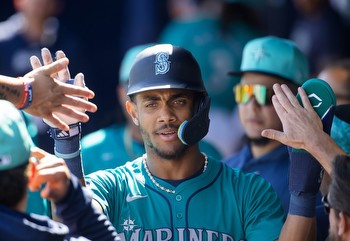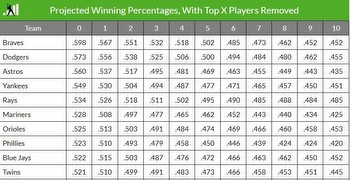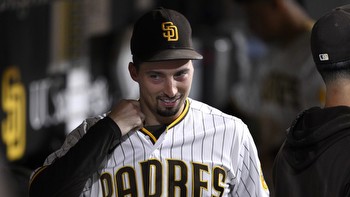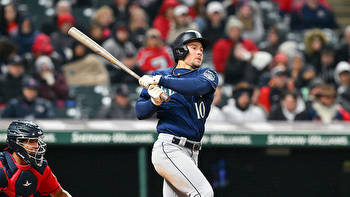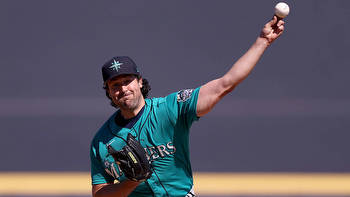Mariners Trade Value Rankings (Part III)
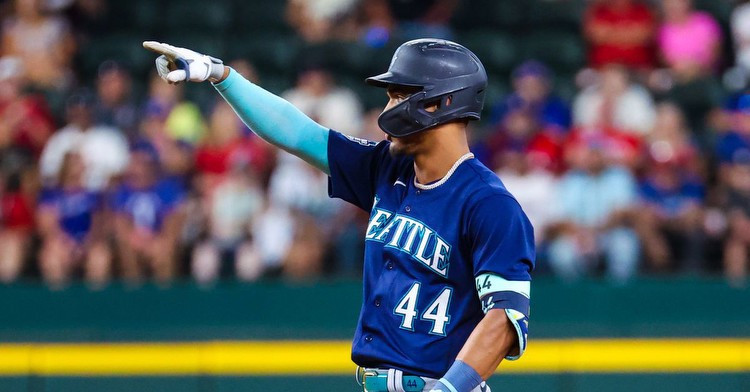
Welcome back for the grand finale of our Trade Value Rankings.
This edition takes a look at our top 11 trade pieces. There are three different tiers with only one player, though very different reasons for each tier being as small as it is.
Once again, here’s a reminder of the ground rules:
- Salaries matter. Would you rather pay Robbie Ray $73m for the next three years or Bryce Miller $6m for the next three years?
- Age matters. Would you rather have Robbie Ray for the next three years or Bryce Miller for the next decade?
- The list is from least to most valuable, but doesn’t include everyone in the organization. I’ve excised the players in the ~middle (so we have players with negative value, and we have players with some sort of positive value). I imagine some teams have very high opinions of Walter Ford, or Aidan Smith, or whoever it may be, and we’ll probably have trades that include those types of players pretty soon. But I’d be surprised if a deal nets us a significant MLB contributor without including one of the names on this list.
- This is about league value, not team-specific value. If the Braves called up Brian Cashman and offered Ronald Acuña Jr. for Aaron Judge, the Yankees would struggle to say yes (though they ultimately might). But it’s unequivocal that Acuña has more league-wide trade value than Judge does. Keep that in mind — some players will have more value to the Mariners than to other teams, but that’s not entirely reflected in this list.
You can also explore the full series:
- Our full spreadsheet with the rankings and a few other notes about each player
Tier 5: Wanna Bet On It?
11. Jarred Kelenic, LF
Kelenic is perhaps the single toughest player to rank on this list. On the one hand, JK is 24 years old and has shown flashes of greatness, backing up a prospect pedigree matched by precious few. On the other, he’s scuffled thus far in the big leagues, ramping up to a .253/.327/.419 slash line in a season marred by a broken foot. He has just one year before arbitration kicks in, which, while not onerous, will add millions to a team’s bottom line compared to a minimum salary.
Some teams would likely rather take a bet on the upside of Ford/Young/Emerson, and it’s hard to blame them. Is Kelenic just another in a long line of prospects who excelled in the minors, only to fall on their faces when faced with MLB breaking balls? Is his ever-rising K% rate a sign of things to come (or things to continue)?
But the upside is there, as every Mariners fan knows.
For all these reasons, Kelenic is tough to value and tough to trade away right now. One can imagine a deal that brings in someone with, say, two years of club control, who could put up 3-4 win seasons. But then again, who’s to say Kelenic couldn’t be that 3-4 win player next season?
Tier 4: Controllable Pitching
10. Bryan Woo, SP
9. Andres Muñoz, RP
8. Matt Brash, RP
7. Bryce Miller, SP
If 2021 was the year of bitcoin as the world’s currency du jour, then 2023’s version is controllable pitching. Whether you want to opt for the starting pitcher who’s hit a top-100 prospect list (and demonstrated real MLB performance) or the lights-out reliever who’s locked up for half a decade, the M’s have you covered. And given the team’s ability to churn out fireballing right arms, I wouldn’t be surprised if Woo or Miller becomes trade bait for the team to improve its offense.
Muñoz is part of this tier because of an extension he signed in November 2021, which guaranteed him millions coming off Tommy John surgery. Without that, he’d be staring at free agency after just two more years. His fastball has set the baseball world ablaze the last two seasons, striking out nearly 1.5 batters per inning over that timeframe, and his contract is equally appealing for teams: He’ll earn just $4.5m over the next two years, and the Mariners have club options for the next three seasons at $6m, $8m, and $10m. Oh, and he doesn’t turn 25 until January.
While Muñoz has been a reliever from the get-go, Brash tried his hand in the rotation before transitioning to the bullpen halfway through 2022. He’s always felt like found money to the Mariners, having come over for Taylor Williams in a 2020 deadline deal, and he truly blossomed last year by leading the league in relief appearances with similarly impressive strikeout numbers to Muñoz. He, too, has a half-decade of club control ahead of him, all at a very reasonable cost. Three seasons of Erik Swanson — a player who put up a similar season to Brash, but five years older and with less of a track record — fetched an All-Star. Five years of Matt Brash would bring back something far more substantial.
Despite the gap between them in this list, Miller and Woo have similar strengths and weaknesses. They have outstanding fastballs and limited professional track record (Woo threw 87.2 IP in MLB this year, up against 101 career minor league IP). Woo’s Baseball Savant page is more impressive than Miller’s, with an 80th percentile xERA and a number of statistics in the top 20-30% league-wide. Miller spikes in walk rate, handing out bases on balls in just 4.8% of plate appearances, but allowed harder contact in ‘23. And both have room to grow, given how the pandemic (and injuries in Woo’s case) stunted their development.
So, which player would fetch more in a trade? I tend to think Miller, given that he had better numbers over a larger sample size in 2023, and given his more advanced secondary offerings. (Between his four-seam and sinker, Woo was throwing his fastball 72.5% of the time last year!) But I do think there’s a case for either, and there’s a case to bring Woo up above the hard-throwing relievers ranked ahead. Starting pitching is such a commodity, especially when there’s year-to-year flexibility rather than massive contracts. I keep the relievers above Woo because they’ve already proven themselves as All-Star caliber players in the bigs. That said, we’re two strong months away from Woo jumping to the top of this tier.
Tier 3: He Means More To Us Than He Does To You
6. J.P. Crawford, SS
While the Mariners have a glut of strong pitching with 3+ years of club control (stay tuned for Tier 2!), the same can’t be said for their position players. There’s a trio of hitters that are heads-and-shoulders above their peers, and we’ll start with our everyday shortstop, our unofficial captain.
2023 marked J.P.’s fifth season as Seattle’s everyday shortstop, but it wasn’t until this year that the switch truly flipped. I mean, Cap rebuilt his game and turned into a star. He was known for walking a lot; suddenly, he’s leading the American League in walks. He hit 17 home runs in 2020-2022 combined; in 2023, he smashed 19. He became the beating heart of the Mariners’ clubhouse, the steady hand, the charismatic leader who everyone roots for.
His extension — which guarantees him $34m over the next three seasons — is below market rate, since without it he’d be looking at a $10m+ arbitration season before signing a $20m-per-year contract to kick off 2025. He’d look good to basically every team in the league. But he’s in this tier for a reason: He’s J.P. Crawford. Trading him would be a significant blow to team chemistry and the clubhouse camaraderie. Trading him, and moving on from the longest-tenured Mariners starter in the Dipoto era, would surely backfire.
Tier 2: Cornerstone Players (But Available For the Right Price)
5. Luis Castillo, SP
4. Cal Raleigh, C
3. Logan Gilbert, SP
2. George Kirby, SP
Trading from this tier would hurt…but it would also bring back something really juicy.
Let’s start with La Piedra. The M’s sent out two top-100 prospects for a year and a half of Castillo, but his trade value has increased since then because of the extension he signed just two months after being acquired. He’ll make $22.75m each of the next four seasons, with a vesting option in 2028 if he racks up 180 innings the previous year. Castillo is a three-time All-Star who’s comfortable at the top of a rotation, and if he were a free agent this year he’d be looking at a deal that guarantees him nearly twice what he’s got on the books right now. In some ways, his numbers fail to represent his “he’s got that dawg in him” statistic, which is surely off the charts. He’s at the bottom of this tier primarily because of his age (31) and the up-front guarantee compared to year-by-year flexibility for others here.
Each player on this tier made an appearance in the FanGraphs Top 50 Trade Value rankings in July — that is, except Cal Raleigh. In fact, Raleigh didn’t even appear in the honorable mention section, an omission that I’m frankly stunned by. Big Dumper still has one more year at minimum salary and three more seasons after that in arbitration. He now has two full seasons hitting above league average, which translates to well above average among backstops. He posted 4.7 fWAR last year and is in the discussion for the best catcher in MLB with Adley Rutschman and Sean Murphy.
Being left off these lists isn’t new for Raleigh; coming up as a prospect, he was always ranked lower than catching counterpart Joey Bart. It might be league-wide perception, honestly, since he didn’t even merit Gold Glove finalist status this year and lost out on a Silver Slugger. But when you look at the numbers, and at the dearth of catching talent across the game, it’s hard to say Raleigh shouldn’t rank in the top four of the trade value rankings, especially given how deftly he’s handled a young pitching corps.
He’d rank higher were it not for the Mariners’ pair of homegrown aces. Logan Gilbert and George Kirby have been everything the Dipoto regime dreamed of and more since being selected in the 2018 and 2019 drafts, respectively. Each threw exactly 190.2 IP in 2023. Gilbert paired that with allowing fewer hits and striking out more hitters, while Kirby led the league in BB/9 by walking just 19 batters all year. Each player has plenty of time left before free agency. I think Kirby has a higher ceiling, but regardless his extra year of club control puts him in the #2 spot over LoGi.
This list isn’t considering the likelihood of being traded, but I’d be surprised if this tier gets dealt. For starters, Castillo has a full no-trade clause as part of his extension, which also means that should he demand a trade, he could posture that he wants to go to one specific team, thereby limiting his market. Trading Raleigh would be robbing Peter to pay Paul, since there’s no legitimate catcher in the organization to hold down the fort in 2024 (and maybe even 2025, too). Gilbert and Kirby could go, but given where the Mariners are in their contention window, they wouldn’t look to acquire prospects, which complicates a deal. My bet is that to beef up the 2024 squad, Dipoto will look to trade from Tiers 4-6.
Tier 1: Julio
1. Julio Rodriguez, CF
What more is there to say? Julio is a superlative talent who’s broken baseball records already. He’s capable of playing as the best baseball player in the world over long periods of time, and he’s the face of this franchise. He’s under contract for somewhere between six and 15 years; while expensive, the deal only skyrockets in value if Julio plays to an MVP level, thereby mitigating risk to the team. He ranked third in FanGraphs’ midseason trade value list, behind only Ronald Acuña Jr. and Wander Franco.
If the Braves offered the M’s Acuña for Julio….they’d at least have a conversation about it. Nobody else in baseball — and I mean nobody else — gets you in the room.
He’s ours, and you can’t have him.


